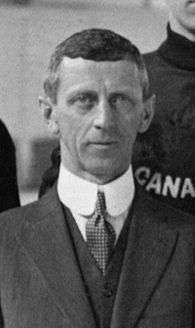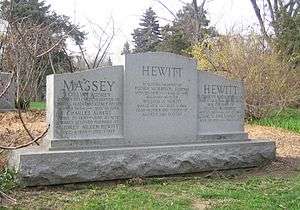W. A. Hewitt
William Abraham Hewitt (May 15, 1875 – September 8, 1966) was a Canadian sports journalist and sportsman.

Journalist
Born in Cobourg, Ontario, Hewitt moved to Toronto when he was four years old and later attended Jarvis Collegiate Institute. Hewitt and his three brothers all worked as journalists in their careers. While still in school, he began working for the Toronto News as a copyboy. At age 15 he was made a reporter and left school. In 1895, he became sports editor of the News and later supplemented his income as press agent for the Grand Opera House in Toronto.
In the fall of 1899, he was lured to the Montreal Herald as sports editor by Joseph E. Atkinson, the paper's managing editor, whom Hewitt had known and admired from Atkinson's days as a reporter in Toronto. A year later, Atkinson became editor-in-chief (and, eventually, majority owner) of the Toronto Star, and Hewitt followed him back to Toronto as the paper's sports editor. Hewitt remained in that role for 31 years, before accepting a job in 1931 as the first attractions manager of the new Maple Leaf Gardens. He passed the reins at the Star over to his long-time colleague, Lou Marsh. Over a 36-year career as a journalist, Hewitt never used a typewriter and wrote all his stories by hand.
Sportsman and manager
According to Gardens' owner Conn Smythe, Hewitt didn't make a smooth transition into his job as attractions manager, and after about a year was given other duties. Hewitt, however, would work at the Gardens for more than 30 years.
For 58 years, he served as secretary of the Ontario Hockey Association, taking the position on what was supposed to be a temporary basis in 1903, and holding it until stepping down in 1966 when he was in his mid-80s. He also served as an officer of the Canadian Amateur Hockey Association between 1915 and 1961.
Hewitt was honorary team manager of three consecutive Olympic gold medal winning hockey teams, the Winnipeg Falcons (1920), Toronto Granites (1924), and Toronto Varsity Grads (1928). He was also referee of the first Olympic hockey game, Sweden's 8-0 victory over Belgium at the 1920 Olympic Games. In 1924, he lost a coin toss to American William S. Haddock to determine who would be second vice-president of the International Ice Hockey Federation.
Hewitt became manager of the Argonaut football team in 1905 and in 1907 helped form the Interprovincial Rugby Football Union, known as the Big Four and comprising the top two teams from the Ontario and Quebec leagues. It would eventually evolve into the eastern division of the Canadian Football League. He served as president of the Canadian Rugby Union in 1918-1919.
Hewitt also had a long involvement with horse racing. In the early years of the 20th century, he arranged discount prices for train rides from Toronto to the Fort Erie Race Track that drew hundreds of passengers and ran daily, at their peak. Starting in 1917, he was a track steward, and in 1937 became presiding steward on the Incorporated Canadian Racing Association. Hewitt held that position until the ICRA was replaced by the Ontario Racing Commission in 1951. He then served as a senior official of the ORC until his retirement.
Legacy

Hewitt was inducted into the Hockey Hall of Fame in 1947. His autobiography, Down The Stretch: Recollections of a Pioneer Sportsman and Journalist, was published in 1958. Hewitt's son, Foster Hewitt became a pioneering hockey broadcaster and also a member of the Hockey Hall of Fame. Foster's son Bill Hewitt followed in his father's footsteps to become the top hockey play-by-play man in Canada. W. A. Hewitt died of liver failure on September 8, 1966.
External links
- Biographical information and career statistics from Legends of Hockey